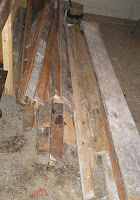His ultimate interest was people and their housing and weather living and working in stackable cubicles is somehow responsible for the slew of immune system problems we run into more and more.
I so wish I could remember this man's name. If anyone has any info on him, please let me know.
Through extensive experimentation he had come to the conclusion that the healthiest shape for the honey bee was an ovoid (egg shaped) hive suspended six feet in the air. He acknowledged that while this might be the best home for the bees it is absolutely useless for the beekeeper as it makes honey collection impossible. A compromise that seems to gain popularity is the top bar hive (TBH).
Here is a quick build along of the Top Bar Hives I will be trying this year.
(Clicking on the small pictures below should enlarge them but you'll need to use your back button to return here)

First find yourself a mess of wood.
I saved the tongue and groove pine floors from a demolition job. There's not much of a chance that they'll ever serve as floors again.

Clean all rough ends and cut boards to lenghth. Notice the lenghth is marked with a perpendicular board nailed to he table. This will save you a lot of repeat measuring.
 I want the slanted walls to be about 16" high so it will take me five flooring boards per side. The boards are pushed together and the ends sanded. The boards will be held together with nailing strips at each end. Sanding them allows me to glue the nailers on. Sanding the ends is not necessary if you are working with clean, new wood or not using glue.
I want the slanted walls to be about 16" high so it will take me five flooring boards per side. The boards are pushed together and the ends sanded. The boards will be held together with nailing strips at each end. Sanding them allows me to glue the nailers on. Sanding the ends is not necessary if you are working with clean, new wood or not using glue. 1.75"nailing strips ripped and cut also from flooring boards.
1.75"nailing strips ripped and cut also from flooring boards. I have not used glue or paint in the past. It doesn't seem right, knowing how much bees rely on smell. I will use glue on these ones mainly because they are not all for me so I can't be there to fix them when the bear decides to tumble them down the hill.
I have not used glue or paint in the past. It doesn't seem right, knowing how much bees rely on smell. I will use glue on these ones mainly because they are not all for me so I can't be there to fix them when the bear decides to tumble them down the hill.Titebond II is low on fumes and the hives will have a couple of weeks outside before the bees arrive.

 Clamp the boards tight and then nail (here I used screws) the nailers in place. The nailers will hold the boards flat and tight so you can release the clamps right away.
Clamp the boards tight and then nail (here I used screws) the nailers in place. The nailers will hold the boards flat and tight so you can release the clamps right away.
The outrage over child labor is a modern overreaction. ;)
What else would they do wit all that time on their hands? Watch TV?
...

... on the other hand... this is what my children call a B-TV. (You guessed right, we don't have a tv in the house. But they'll get the Nature Channel on these observation hives.)

Yes, still using recycled wood (and buying nice tools with the savings.)
:)

The lineup. Next steps are bottoms, paint, top bars, and covers